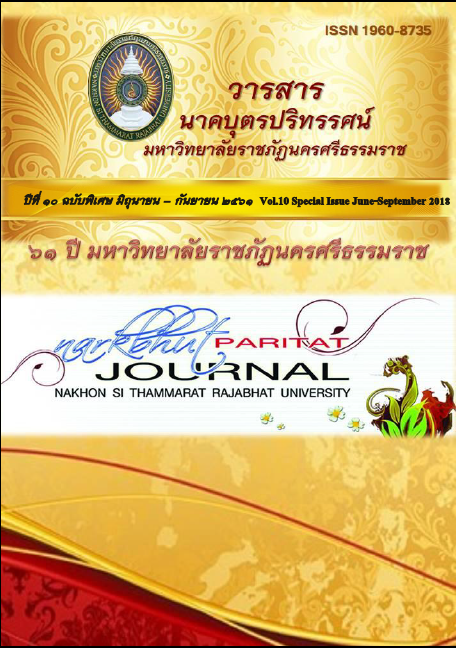ผลการใช้กิจกรรมการเรียนร่วมกันกับเพื่อนสนิทและคนรู้จักโดยใช้กูเกิลด็อกเพื่อส่งเสริม การคิดอย่างมีวิจารณญาณของนักศึกษามหาวิทยาลัยราชภัฎสุรินทร์ The Effects of Collaborative Learning Activities with Close Friends and Acquaintances using Google Doc to Promote Critical Thinking of Surindra Rajabhat University Students
Main Article Content
บทคัดย่อ
งานวิจัยนี้มีวัตถุประสงค์เพื่อ 1) ศึกษาผลการใช้กิจกรรมการเรียนร่วมกันกับเพื่อนสนิทและคนรู้จักโดยใช้กูเกิลด็อกเพื่อส่งเสริมการคิดอย่างมีวิจารณญาณ 2) เปรียบเทียบผลการใช้กิจกรรมการเรียนร่วมกันกับเพื่อนสนิทและคนรู้จักโดยใช้กูเกิลด็อกเพื่อส่งเสริมการคิดอย่างมีวิจารณญาณ ระหว่างคะแนนก่อนเรียนและคะแนนหลังเรียน และระหว่างรูปแบบการจัดกลุ่มต่างกัน 3 รูปแบบ โดยมีกลุ่มตัวอย่างประชากรเป็นนักศึกษามหาวิทยาลัยราชภัฏสุรินทร์ จำนวน 114 คน เครื่องมือที่ใช้ในการวิจัยประกอบด้วย กิจกรรมการเรียนร่วมกันโดยใช้กูเกิลด็อก แบบวัดการคิดอย่างมีวิจารณณาญ วิเคราะห์ข้อมูลโดยใช้ค่าเฉลี่ย ส่วนเบี่ยงเบนมาตรฐาน สถิติทดสอบค่าที (t-test) และสถิติทดสอบค่าเอฟ (F-test)
ผลการวิจัย พบว่า
- ก่อนเรียนคะแนนการคิดอย่างมีวิจารณญาณของนักศึกษามหาวิทยาลัยราชภัฏสุรินทร์ อยู่ในระดับสูงมากร้อยละ 0 ระดับสูงร้อยละ 36.84 ระดับพอใช้ร้อยละ 30.70 และระดับต่ำถึงต่ำมากร้อยละ 24.56 และ 7.90 ตามลำดับ ส่วนหลังเรียน คะแนนการคิดอย่างมีวิจารณญาณของนักศึกษามหาวิทยาลัยราชภัฏสุรินทร์ อยู่ในดับสูงมากร้อยละ 3.51 ระดับสูงร้อยละ 38.60 ระดับพอใช้ร้อยละ 30.70 และระดับต่ำถึงต่ำมากร้อยละ 20.17 และ 7.02 ตามลำดับ
- คะแนนการคิดอย่างมีวิจารณญาณหลังเรียนสูงกว่าก่อนเรียนอย่างมีนัยสำคัญทางสถิติที่ระดับ .05
- คะแนนการคิดอย่างมีวิจารณญาณ จำแนกตามรูปแบบการจัดกลุ่มของผู้เรียน ไม่แตกต่างกัน
Article Details
ประเภทบทความ
บทความวิจัย
เอกสารอ้างอิง
Bulu, S. T., & Yildirim, Z. (2008). Communication Behaviors and Trust in Collaborative Online Teams. Educational Technology & Society. 11 (1): 132-147.
Goodsell, A.N., Maher, R.M, Tinto. (1996). Collaborative learning: A source book for higher education. The National Center on Postsecondary Teaching, and Assessment (NCTLA).
Hanham, J., & McCormick, J. (2009). Group work in schools with close friends and acquaintances: Linking self-processes with group processes. Learning & Instruction, 19(3), 214–227. doi:10.1016/j.learninstruc.2008.04.002
Isaranggoon, W. (2012). Social Studies Teacher and Student Development. Bangkok: Chulalongkorn University. (in Thai).
Johnson, D.W. and Johnson, R.T.An. (1994). Overview of Cooperative Learning. Creativity and Collaborative learning. Baltimore Maryland: Paul H. Brookes Publishing.
Johnson, K., McHugo, C., and Hall, T. (2006). Analyzing the efficacy of blended learning using Technology Enhanced Learning (TEL) and m-Learning delivery technologies. Retrieved September 15, 2017 from https://www.ascilite.org/conferences/sydney06
/proceeding/pdf_papers/p73.pdf
Jones, S. and Creese, L. (2001). E-education: Creating partnerships for learning. Retrieved September 15, 2017 from https://ultibase.rmit.edu.au/Articles/aug01/jones1.htm
Mezirow, J. (1981). A critical theory of adult learning and education. Adult Education Quarterly, 32 (Fall), 3-24.
Oliver, R. (2001). Exploring the development of critical thinking skills through a web-supported, problem-based learning environment. In J. Stephenson (Ed.), Teaching and learning online: pedagogies for new technologies, London: Kogan Page, 98-111.
Sills, Digby, A., & Russ, P. (1991). Cooperative learning: A guide to research. New York: Garland.
Suwan, C. (2009). Development of Critical Thinking Training Program Sufficiency Economy For the student teacher Upper Northern Rajabhat University. A thesis of the Requirement for the Doctoral Degree, Chiang Rai Rajabhat University. (in Thai).
Tabtimtong, A. (2009). The Development of the Web Lessons to Promote Critical Thinking about Computer Technology for Students in Mathayomsuksa 4-6. A thesis of the Requirement for the Master Degree of Faculty of Education, Dhonburi Rajabhat University. (in Thai).
Watson, G. and E. M. Glaser. (1964). Critical thinking appraisal manual. New York: Harcourt, Brace, and World.
_________. (1980). Watson-Glaser critical thinking appraisal. Texas: The Psychological Corporation.
Wenyi Zhou, Simpson, E., & Domizi, D. P. (2012). Google Docs in an Out-of-Class Collaborative Writing Activity. International Journal of Teaching & Learning in Higher Education, 24(3), 359–375.
Goodsell, A.N., Maher, R.M, Tinto. (1996). Collaborative learning: A source book for higher education. The National Center on Postsecondary Teaching, and Assessment (NCTLA).
Hanham, J., & McCormick, J. (2009). Group work in schools with close friends and acquaintances: Linking self-processes with group processes. Learning & Instruction, 19(3), 214–227. doi:10.1016/j.learninstruc.2008.04.002
Isaranggoon, W. (2012). Social Studies Teacher and Student Development. Bangkok: Chulalongkorn University. (in Thai).
Johnson, D.W. and Johnson, R.T.An. (1994). Overview of Cooperative Learning. Creativity and Collaborative learning. Baltimore Maryland: Paul H. Brookes Publishing.
Johnson, K., McHugo, C., and Hall, T. (2006). Analyzing the efficacy of blended learning using Technology Enhanced Learning (TEL) and m-Learning delivery technologies. Retrieved September 15, 2017 from https://www.ascilite.org/conferences/sydney06
/proceeding/pdf_papers/p73.pdf
Jones, S. and Creese, L. (2001). E-education: Creating partnerships for learning. Retrieved September 15, 2017 from https://ultibase.rmit.edu.au/Articles/aug01/jones1.htm
Mezirow, J. (1981). A critical theory of adult learning and education. Adult Education Quarterly, 32 (Fall), 3-24.
Oliver, R. (2001). Exploring the development of critical thinking skills through a web-supported, problem-based learning environment. In J. Stephenson (Ed.), Teaching and learning online: pedagogies for new technologies, London: Kogan Page, 98-111.
Sills, Digby, A., & Russ, P. (1991). Cooperative learning: A guide to research. New York: Garland.
Suwan, C. (2009). Development of Critical Thinking Training Program Sufficiency Economy For the student teacher Upper Northern Rajabhat University. A thesis of the Requirement for the Doctoral Degree, Chiang Rai Rajabhat University. (in Thai).
Tabtimtong, A. (2009). The Development of the Web Lessons to Promote Critical Thinking about Computer Technology for Students in Mathayomsuksa 4-6. A thesis of the Requirement for the Master Degree of Faculty of Education, Dhonburi Rajabhat University. (in Thai).
Watson, G. and E. M. Glaser. (1964). Critical thinking appraisal manual. New York: Harcourt, Brace, and World.
_________. (1980). Watson-Glaser critical thinking appraisal. Texas: The Psychological Corporation.
Wenyi Zhou, Simpson, E., & Domizi, D. P. (2012). Google Docs in an Out-of-Class Collaborative Writing Activity. International Journal of Teaching & Learning in Higher Education, 24(3), 359–375.


